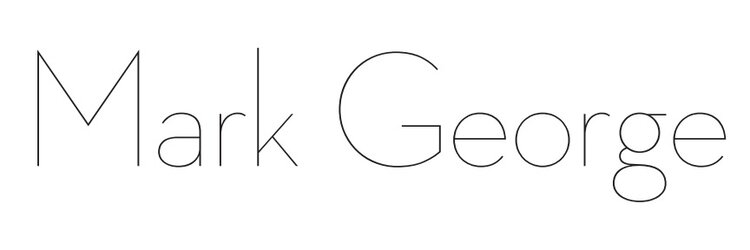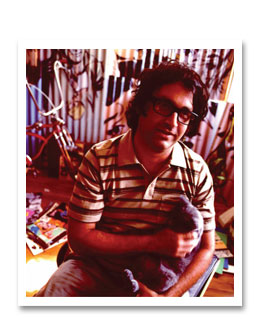Will Paint for Food
By Jessica Palombo
Jacksonville Magazine November 2007
Vincent Van Gogh died broke. Michelangelo couldn’t express his vision without battling censorship and criticism. Toulouse- Lautrec drank himself to death after a brief life plagued with poor health. Oftentimes being an
artist is a difficult way to make a buck.
While there are always exceptions, like Pablo Picasso and American pop artist Andy Warhol, who enjoyed the spoils of monetary success and fame while still alive, the fact remains that most creative souls aren’t so lucky. Just ask
Mark George.
A 16-year veteran of the Jacksonville art scene, George is having a record business year in terms of sales. But business wasn’t always so good. In the first year since he moved to the Riverside area in 1991, he sold six paintings
before the summer. In an average year, he sells ten pieces at $500 to $3,500 each. “Things get easier as time goes by,” he says. “In the past, the market wasn’t there as much as it is today.”
George attributes a friendlier market, in part, to a thriving community of artists that has grown over the past ten years. “The art crowd kind of flocked to [Riverside],” he says, because of the new homes and businesses springing up.
George, 36, paints on transparent corrugated roofing material. His jagged-edged works are meant to look like “found” pieces of pop culture from bygone days—a
torn-off corner from a 1960s billboard, for example. He aims to incorporate recognizable bits of Americana,
which he calls “iconic references,” without being too obvious. “I might not have an exact James Dean
look-alike, but I might have a guy with a pompadour hairstyle,” he says.
George says the influx of artists to town does not directly threaten his business. On the contrary, “It’s always nice to see what someone else is doing,” he says. “It definitely makes things more intriguing.” Plus, he says, if anartist finds true competition, he’s doing something wrong. “You should have your own style. If you don’t have that style, what do you have?” Patrons at several art spots, such as Jane Gray Gallery and The Gallery at Screen Arts in St. Augustine, have embraced his pop art with open arms.
Today, George’s favorite exhibitions are at “lowbrow” venues, places where the public may not expect it. In addition to more traditional galleries, his work has appeared in the San Marco Theatre, the Fox Restaurant in Avondale and several bars around town. “You’re showing
art to people who, in some cases, have no exposure to it otherwise,” he says.
Exposure is great, but the name of the game is sales.
And paying customers can be tough to find.
“You get used to not selling a lot of work,” George says of his career. “After a while, it can get pretty daunting. You start to question yourself, am I doing the right thing, especially as you get older.”Another struggle was to resist counting your chickens before they hatch when it came to
expected sales. Many “interested” buyers are never to be heard from again. Today, he tries to take people’s interest as a compliment and nothing more—until the check clears.
Waiting around for customers does not pay for new paintbrushes. Thus, he has washed dishes,printed signs, and even run a landscaping service from the back of his Honda Civic to supplement his income. Today, he enjoys working as a graphic designer at a San Marco sign shop.
George suspects he’s not alone in seeing brighter days ahead for Jacksonville artists. “It’s gonna be easier for people to get a fresh start than it was ten years or 20 years ago,” he says.
Amy Crane, deputy director of the Cultural Council of Greater Jacksonville, says the region is experiencing a cultural renaissance of sorts, due to programs like Art in Public Places made possible by the Better Jacksonville Plan. “The Jacksonville community is experiencing a
heightened awareness and excitement about art,” she says. Since 2003, the Council has overseen 26 major installments of artists’ work in prominent places like the main library branch and Veterans Memorial Arena.
Leigh Fogle, who has run Fogle Fine Art and Accessories for 13 years, acts as a liaison between artists and customers looking to purchase art for their businesses
and homes. She says people today place much more importance on art than they did ten years ago. She is
inundated with artists sending their portfolios and with clients requesting special pieces, ranging from
poster-sized prints to $25,000 originals. Although there
is a higher demand for art, Fogle says artists should not expect to fully support themselves when starting out. “Youcan’t just come out of the box and start selling
at that price,” she says. To be truly successful, she suggests submitting work to several galleries across the country, not just in Jacksonville. And, while this strategy may get them recognition, artists must keep in mind that galleries take between 30 and 60 percent commission on
anything they sell.
Courtney Donnell Vickery, a painter with six months of professional experience, says the North Florida market is better than she could have imagined. “It’s been fantastic,” she says. “I was expecting a slow start, but I’ve been very pleasantly surprised.”
Vickery, a 24-year-old Orange Park native, discovered her artistic talent at St. Johns Country Day School and later honed it as a Fine Arts major at Clemson University. Her Floridian nature scenes, still lifes, and abstract landscapes have attracted an audience at festivals
like the Ponte Vedra Art Festival and the Shrimp Festival
in Fernandina Beach, where she sold about 10 paintings each. She also does one or two pieces on commission each month, earning between $400 and $1,500 per painting.
She may not struggle to find customers or to pay her bills, but Vickery faces plenty of challenges as an artist. “Finding inspiration has been the hardest part,” she says. “The main thing is having faith in yourself.”
What started as an experiment with a two year time limit has allowed her to cut back working her other job at Stellers Gallery to two days per week, and she plans to keep it that way. “You get one life,” she says, explaining why she can’t just settle on another job.
Vickery says her dreams are to see her work added to the collection of a prestigious museum and to be represented by well-known and respected galleries. George has his sights set on international acclaim. After conquering the
Miami and San Francisco markets, he would like to take it overseas to London and Japan.
George’s dream may not be out of reach, as other First Coast artists have demonstrated. Graphic artist and Jacksonville native R. Land achieved commercial success after moving to Atlanta in the mid-‘90s. Land’s “Loss Cat”
poster design, which began as irreverent street art affixed to telephone poles, eventually adorned T-shirts sold by national retail chain Urban Outfitters and was featured in the popular Found book series.
“We’re a gateway to other cities,” George says of the Jacksonville art scene. “It’s refreshing to see people who have worked hard and have made it.”
These inspirations come in handy as a pickme-up when the cash isn’t flowing in. But for now, George says he’s just enjoying exposing new audiences to art. “It’s been really rewarding to see young people, two-year-old kids, hanging onto an art flier. It’s kind of a beautiful thing…
sharing not only with art connoisseurs, but people from all walks of life.”

